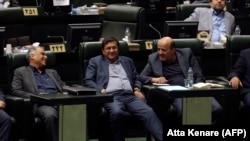The rate of exchange for the U.S. dollar has risen 2,700 times during the past 41 years since the start of clerical rule in Iran under the Islamic Republic system.
During the past two weeks the rate has been nearing 210,000 rials per dollar due to an extremely sharp devaluation of Iran's national currency.
The decline has been attributed by the media to a widespread systematic financial corruption, thanks to revelations made by the country's civil society, foreign-based Persian-speaking media and international institutions.
The Central bank of Iran (CBI) has been in the center of the economic chaos that has led to wasting billions of dollars of national resources by offering unjustified privileges to well-connected regime insiders and failing to carry out its initial mission.
A 1972 law tasked the CBI "to carry out monetary policies to pave the way for the country's progress, back the government's development plans and preserve the value of national currency through maintaining a balance in payments." The law from the monarchy period has been preserved with minor changes.
Preserving the value of the national currency is the most important of these three missions. Incidentally, the CBI is facing a historic failure in this area which has discredited the Central Bank as a key national institution.
An independent central bank would not submit to the pressures of chaotic governments and print bank notes to cope with budget deficits.
The constant decline in the purchasing power of the Iranian national currency during the past 41 years has taken place in parallel with heavy inflation, with an average rate of 20 percent per annum. This is seven times higher than the world average inflation rate during the same period.
The decline in the value of national currency is only one of the manifestation of the Islamic Republic of Iran's Central bank's catastrophic failure. In a matter of four decades the Iranian currency has been devaluated by 2,700-fold, making the rial one of the weakest currencies in the world.
Obviously, the CBI is not the only culprit for this decline which is the outcome of atotal collapse in the country's production system and the inconsistency of policies with the requirements of the 21st century. In the meantime, instead of looking for a way out of the crisis, the CBI and its governors have obediently listened to what the government dictated and turned the Iranian money into ashes.
In order to protect the value of the national currency based on national interests, they should not have feared political leaders and made their own independent decisions about monetary policies including those about the volume of cash available in circulation and interest rates.
An independent central bank would not submit to the pressures of chaotic governments and print bank notes to cope with budget deficits. This always disrupts price stability and erodes trust in the national currency. The Iranian Central bank has done just the opposite. As a weak institution, the CBI has submitted to pressures of the Supreme Leader, the government and even the parliament (Majles). This has been one of the reasons why Iran has been suffering from such an unusually high rate of inflation and devaluation of its national currency.
The absolute obedience to the government has made the CBI the most important tool for carrying out a policy whose main result is high inflation that has turned life into misery for many Iranians now living under the poverty line.
The same absolute obedience to the government has led the bank to manage the forex market in a way that led to plundering of billions of dollars of the country's financial resources by influential insiders.
The CBI recently admitted that it pumped $280 billion petrodollars into the local currency exchange market to artificially keep rial high in recent years.
In such a system, the Central Bank oversees the fluctuations in the forex market and tries to influence them based on political interests rather than real economic factors, totally ignoring economic realities. But such a policy cannot continue in the long-run. Soon, the country's economy and businesses feel the shock and pressure of this fabricated balance in the market. This has been happening over and over as the government injected U.S. dollars into the forex market to keep the rate of exchange and the prices lower than what the market calls for.
Pouring money into the market is usually followed after a while by sudden and unusual rises in the rates of exchange and reality overcomes the manipulated market. This situation has not only wasted billions of dollars of the country's resources, it has also paved the way for the well-connected few to take advantage of the situation and plunder what is left.
Central Bank Governor Abdolnasser Hemmati explained part of this mechanism that gives way to this form of plunder during a meeting at the parliament in early June. "We have injected $280 billion into the forex market during the past 15 years in order to control the rate of exchange. That is $18 billion dollars a year. Most of this money has exited the country by a number of individuals who had access to dollars at a very low rate. In other words, the people paid subsidies to those who were buying real estate abroad."
Hemmati speaks in a way as if this policy was a thing of the past. But it is still continuing. Only a few days later he revealed that another $100 million dollars was poured into the market to keep the rate of exchange lower. And President Hassan Rouhani "ordered" the Central bank on June 26 "to continue its targeted intervention in the forex market." He does not want his presidency to end next year with the rate of exchange flying at 300,000 to 400,000 rials against the dollar.


